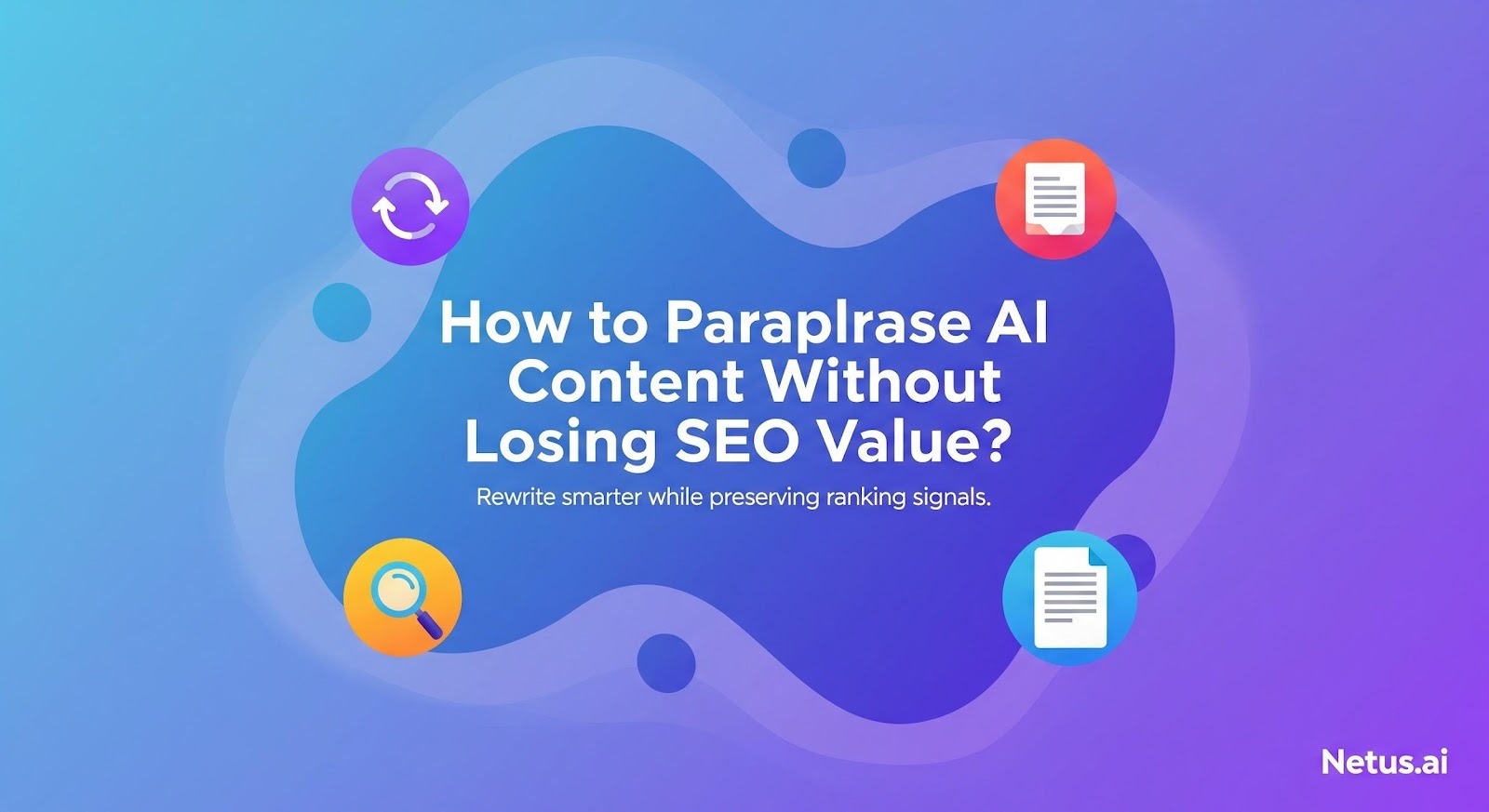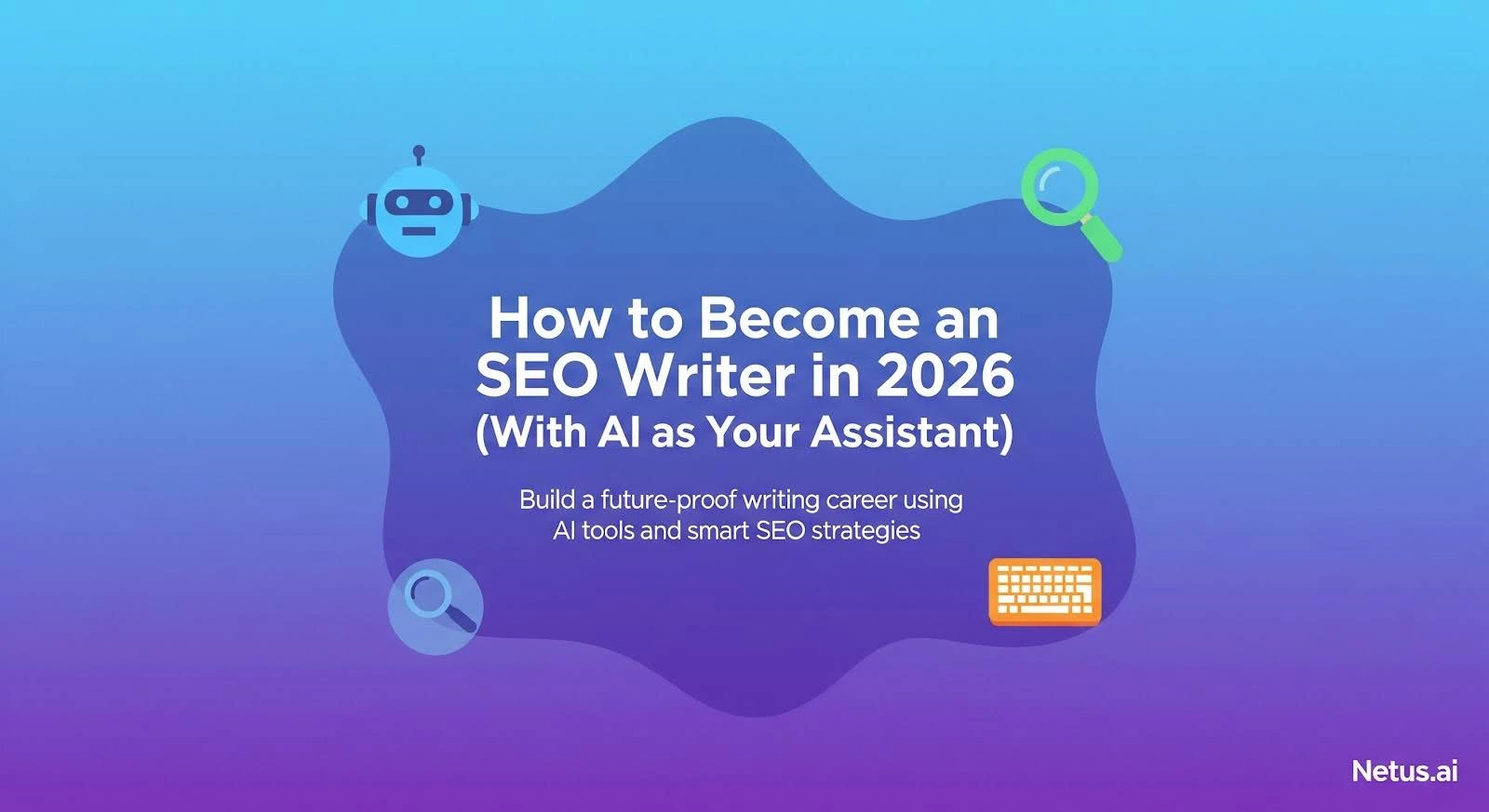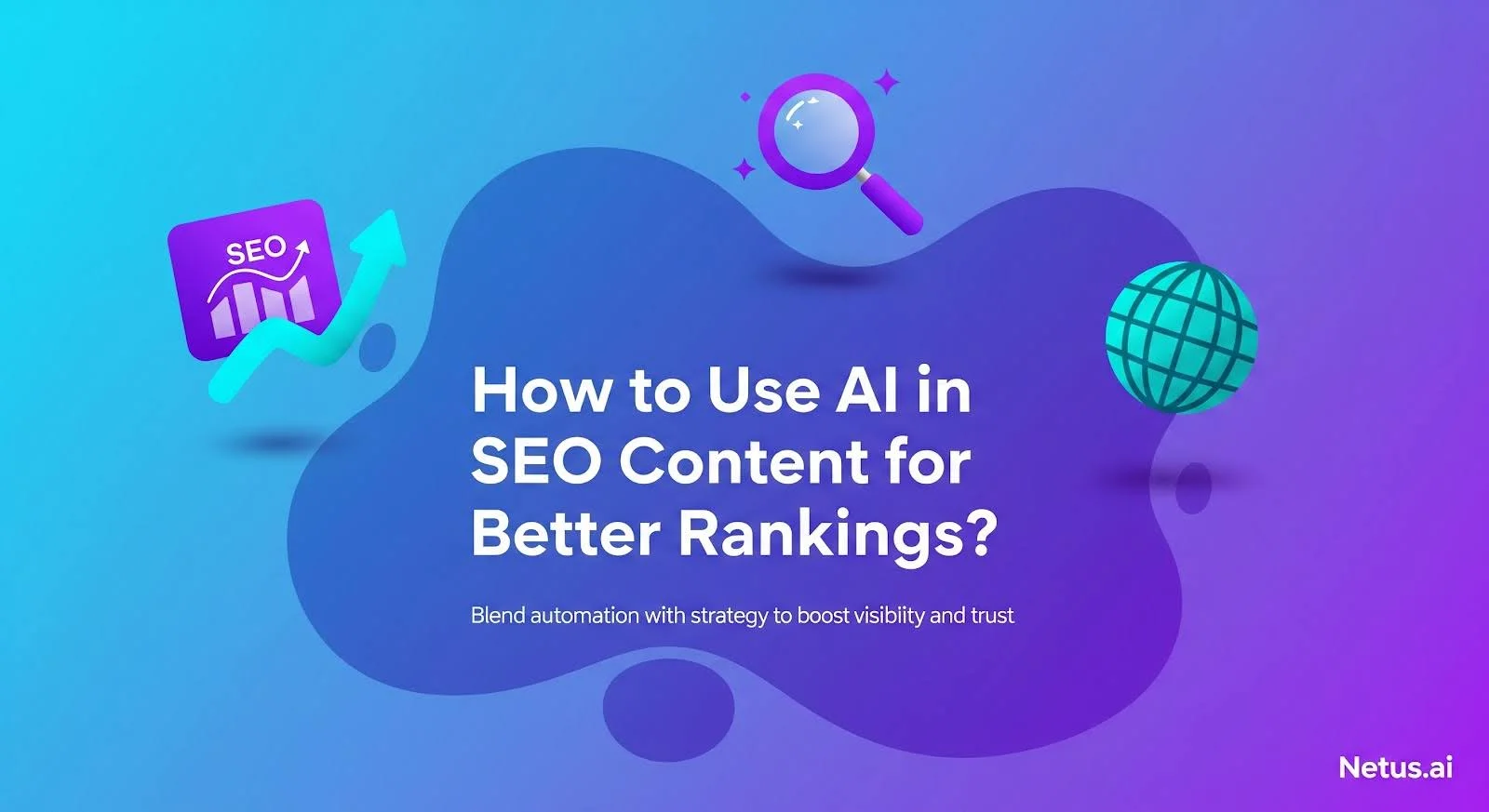You used AI for speed and scale, producing seemingly decent, grammatically sound content.
However, your organic traffic is dropping, pages are vanishing and engagement is falling. The growing worry: Are your AI-written articles hurting your rankings?
The ease of pure AI-generated content is fading in 2026. Google’s algorithms now aggressively filter content lacking human value, moving past vague “quality” warnings to concrete actions against pages failing to demonstrate EEAT (Experience, Expertise, Authoritativeness and Trustworthiness).
Relying only on raw AI output is a fast track to digital obscurity. The goal is to rescue your content and rankings by refining, not abandoning, AI.
The AI content hangover: Why is this question critical?
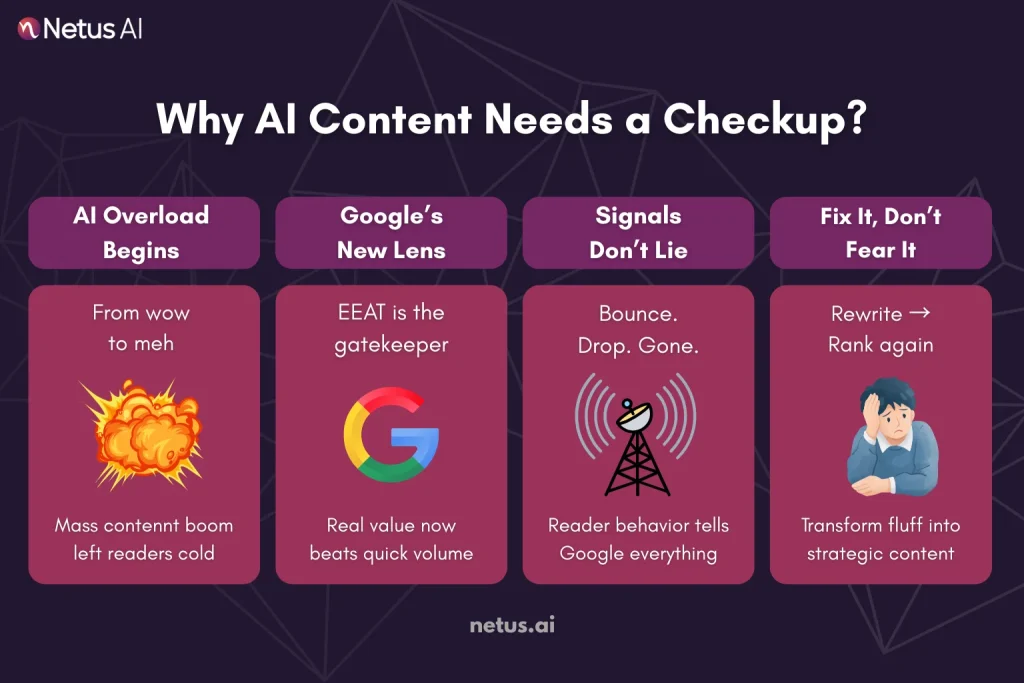
The rise of accessible AI writing tools led to a flood of surface-level content. Google’s focus on EEAT and “helpful content written by people, for people” means unedited AI content often fails to rank.
It lacks depth, expertise and trust. Google’s systems are increasingly good at spotting it, leading to reduced visibility and lost rankings. This is about diagnosing if AI content is hurting your rankings and providing strategies to fix it.
The red flags: Signs your AI content is sabotaging your SEO
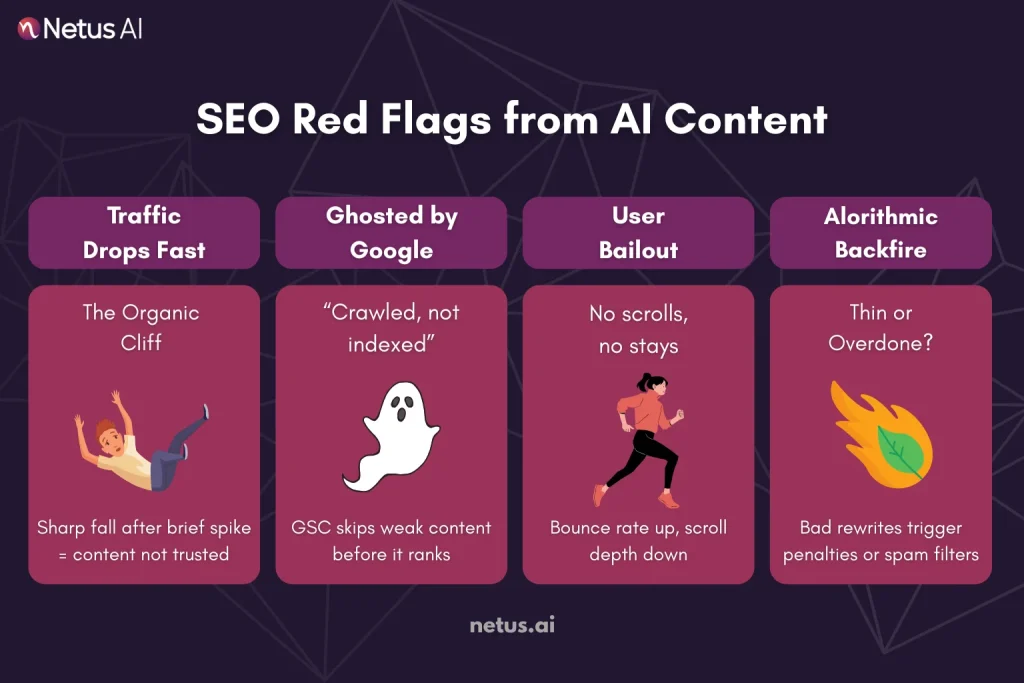
Ignoring the issue won’t help. If rankings are dropping, the cause is often unrefined AI content.
- The organic traffic cliffhanger: This is the most glaring signal. You publish an AI-generated piece, maybe it even gets a brief initial bump but then organic traffic plummets precipitously.
Cliff-like fall suggests Google quickly demoted the page after deeper evaluation or observing poor user signals. It’s the algorithm declaring: “This isn’t meeting the bar.”
- The Google search console (GSC) ghost town: Check your GSC coverage report. Are pages you know you published (likely AI-assisted) marked as “Crawled, currently not indexed” or “Discovered, currently not indexed“? This is Google essentially saying, “We saw it but we don’t deem it worthy of showing in search results.”
It’s a pre-penalty filter specifically designed to keep low-value or problematic content out of the index. Raw AI output frequently triggers this.
- Engagement evaporates: Look beyond rankings to user behavior. Has your bounce rate for AI-generated pages skyrocketed? Are session durations painfully short? Are scroll depths shallow?
These metrics scream that visitors arrive, instantly sense something is “off” or unhelpful and flee. Google interprets this mass exodus as a powerful negative ranking signal, your content isn’t fulfilling user intent. Comments sections on these posts? Likely crickets or generic spam. Genuine engagement requires genuine connection, which unedited AI often lacks.
- The thin content or over-optimization whisper: Sometimes, the penalty is more direct. You might receive a manual action notification in GSC (less common but possible for egregious spam) or see algorithmic flags for “thin content.”
Trying to “SEO-ify” generic AI text by unnaturally keyword-stuffing can trigger over-optimization filters, resulting in an awkward, robotic mess unappealing to users and search algorithms.
Your focus on AI content SEO and Google ranking AI becomes counterproductive if the foundation is flawed.
This isn’t a coincidence but a direct consequence of content failing Google’s EEAT and user expectations. Fluent machine-generated prose lacks the substance search engines and users require.
Why Google turns its back: The core flaws of unedited AI Writing
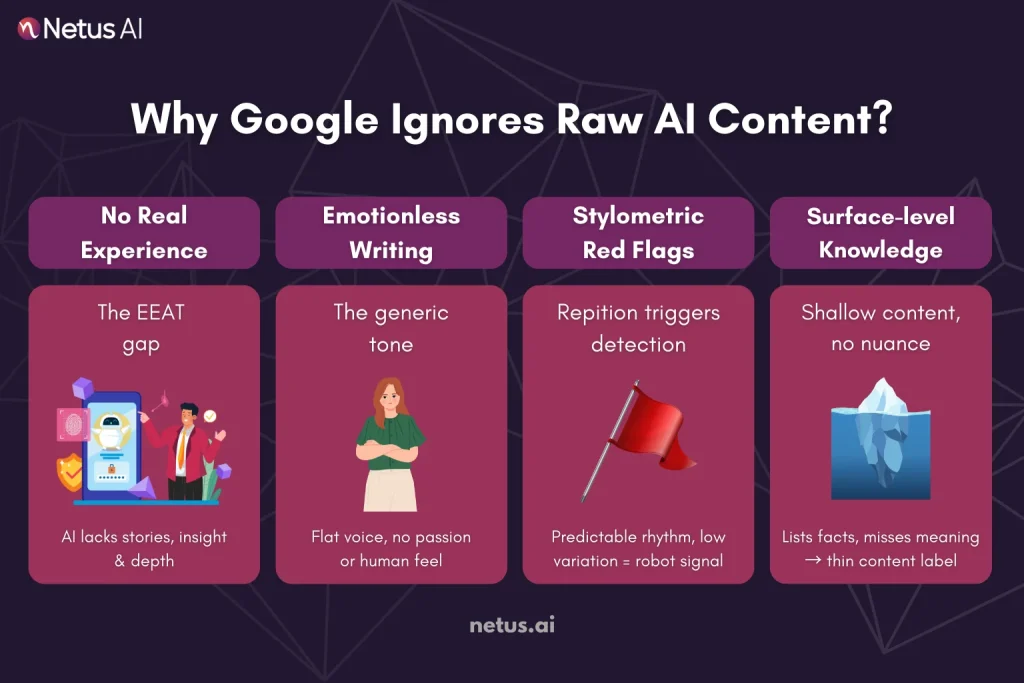
Google penalizes/ignores AI writing because it often conflicts with their mission to deliver the most helpful, reliable results and directly undermines EEAT.
- The EEAT Vacuum: This is the heart of the issue.
- Experience:AI has none. It cannot share a personal anecdote, a hard-won lesson or the tactile feel of using a product. Its writing is observational, not experiential.
- Expertise:While AI synthesizes information, it lacks true understanding, critical analysis or the ability to offer novel insights born from years of study. Its “expertise” is derivative and surface-level.
- Authoritativeness: Authority is earned through reputation, citations, original research and demonstrable knowledge. AI can only mimic authoritative writing, lacking true depth and credibility.
- Trustworthiness: Trust is eroded by AI factual errors, generic advice and the lack of an accountable human voice.
- The hallmarks of robotic prose (stylometrics): Google’s algorithms and specialized SEO detection tools analyze patterns invisible to the casual eye:
- Repetitive rhythms: AI often falls into predictable sentence structures and lengths. Paragraphs may follow rigid templates. The flow feels mechanical, not organic.
- The generic tone: Raw AI output frequently suffers from a bland, anonymous voice. It lacks the subtle passion, skepticism, humor or personality a human expert injects. It’s emotionally flat.
- Lack of true depth & nuance: AI content often lacks depth, connecting points poorly or failing to explore counter-arguments/the “why.” This surface-level writing is often perceived as “thin content.”
- Predictable language patterns: Advanced detection models analyze “perplexity” (how predictable word choices are) and “burstiness” (variation in sentence complexity). AI text often scores highly on predictability and low on natural variation, a digital fingerprint.
- The uncanny valley of information: Sometimes, AI content is just accurate enough to be published but lacks the subtlety, context or critical perspective a human expert provides.
It might state facts but miss underlying implications or offer generic advice unsuitable for complex situations. This superficiality is a major EEAT red flag. Readers seeking genuine help feel unsatisfied, leading to those damaging engagement drops.
- The uncanny valley of information: Sometimes, AI content is just accurate enough to be published but lacks the subtlety, context or critical perspective a human expert provides.
Content starts at generation: NetusAI’s SEO article writer and content generator
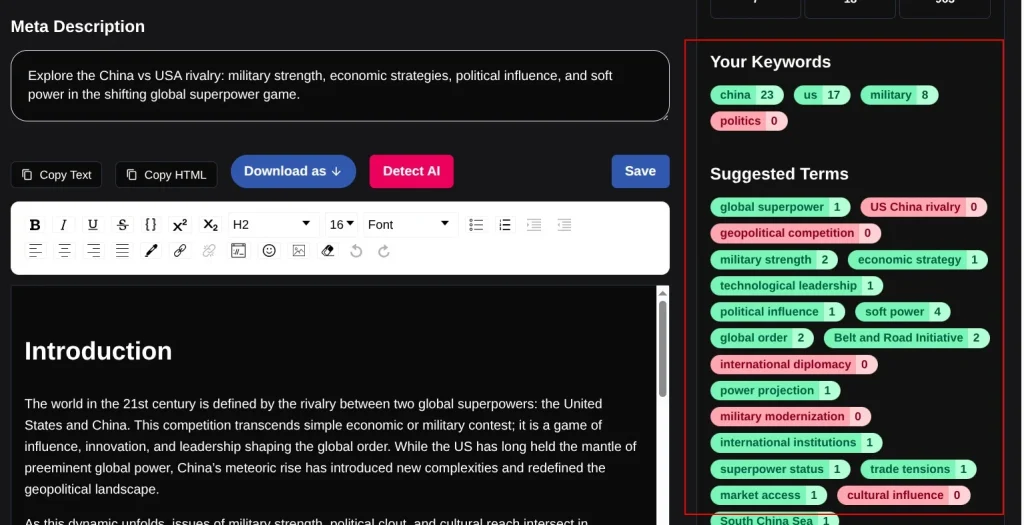
Avoiding stylometry and detection issues shouldn’t begin after content is written, it should start with the writing itself. That’s where NetusAI steps in.
Unlike generic AI tools that churn out robotic, easily flagged paragraphs, The NetusAI SEO Article Generator is designed to help you create full-length blog posts that are already optimized for clarity, tone and search intent. Unlike generic tools, it goes beyond simple drafting. It:
- Lets you input headlines and targeted SEO keywords
- Supports long-form templates for full blogs
- Auto-generates a structure with Title → Outline → Content
- Works in multiple languages for global teams
And most importantly: it ties directly into the Netus AI Bypasser + Detector system, meaning your output isn’t just readable, it’s already tuned to avoid detection.
You can generate, review and rewrite all in one interface without needing third-party tools to patch the gaps. It’s built for marketers, freelancers and bloggers who want their AI content to actually pass as human-written.
Content Generator
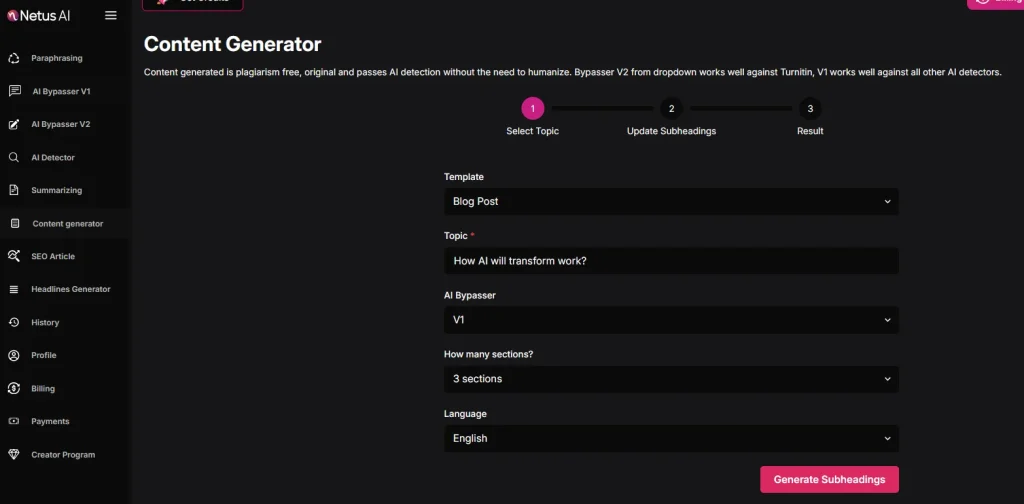
NetusAI also offers a Content Generator. Following the simple steps as shown on the user-friendly NetusAI page, Plagiarism Free Content will be generated from the beginning. The result generated can be downloaded and copied directly as well. Users can easily view their results as they will be stored in the history tab.
So whether you’re starting from scratch or turning an idea into a full SEO article, NetusAI saves you time and rewrites, without sacrificing trust or quality.
Final thoughts
AI writing isn’t the enemy, lazy AI writing is. If your content sounds like it was generated in one click and shipped without editing, Google will treat it like filler. But when you combine the speed of AI with human oversight, structure and intent, you get scalable content that actually ranks.
That’s why the smart play is hybrid creation, with NetusAI, you can:
- Write with structure using the SEO Article Writer
- Plagiarism free Content Generator
- Detect and fix red flags with the AI Bypasser
FAQs
Look for warning signs like dropped rankings, low time-on-page, pages stuck in “Crawled, not indexed,” and high AI detection scores. These usually indicate that your content lacks depth or sounds too machine-written.
Run them through a tool like NetusAI, which detects robotic patterns and offers rewrite suggestions. Focus on restructuring the content, adding original insights and editing for clarity and tone.
Absolutely. Rewritten content that feels more human, includes real insights and avoids AI “tells” performs significantly better in search, both in visibility and engagement.
Yes. Through stylometry, pattern recognition and quality signals, Google’s algorithms can identify content that lacks originality, context or human logic. That’s why humanization tools are essential.
NetusAI is built for this exact use case. It offers real-time AI detection and rewrites your content to be more human, structurally sound and SEO-friendly, all in one workflow.


